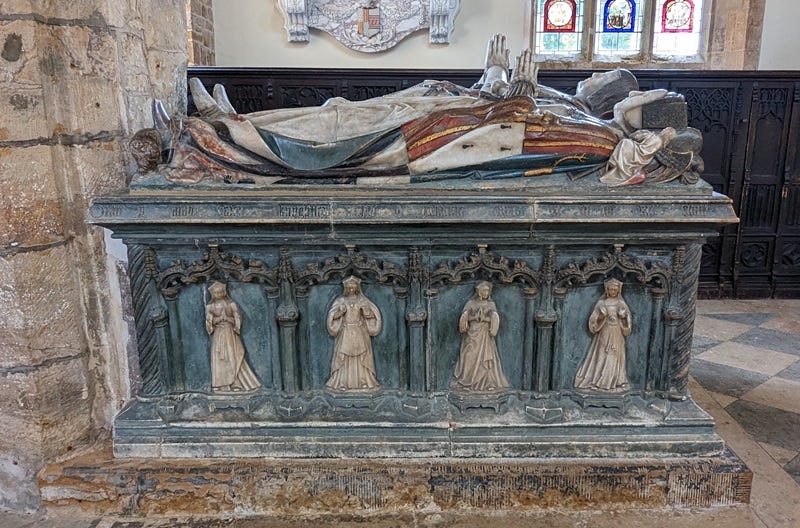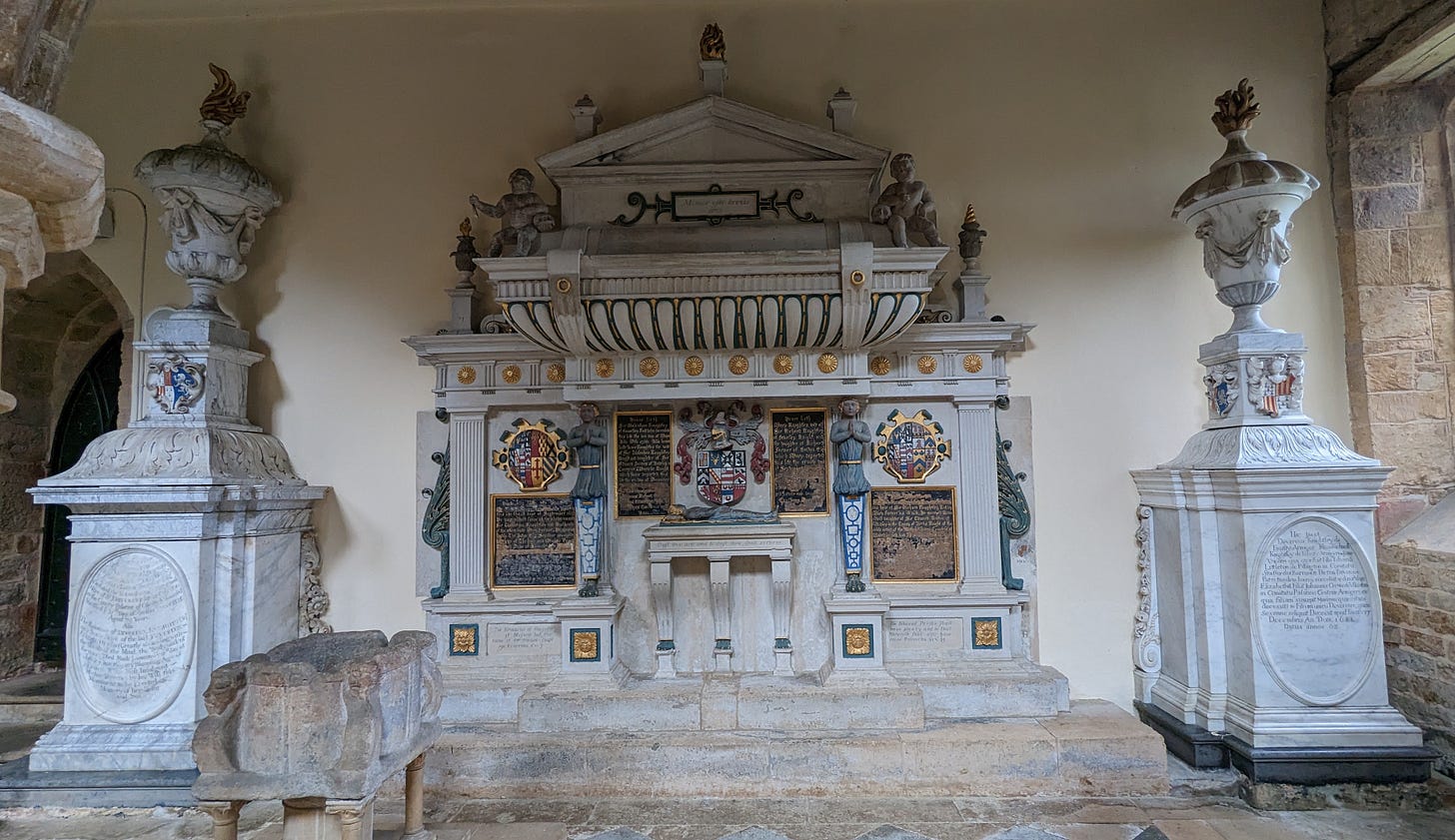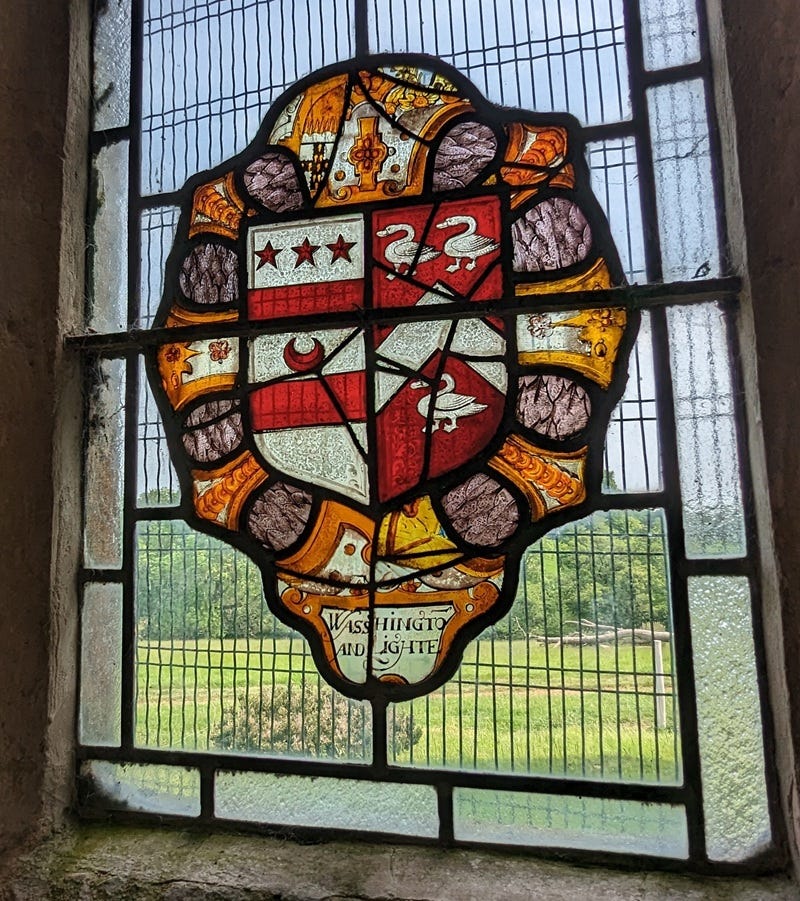A tiny church and its many memorials
Plus Old Glory's ancestor, the Elephant Man, Winston Churchill, and lots of sheep!
The British countryside is full of oddities thanks to things which happened long before living memory. Take, for example, the village of Fawsley in Northamptonshire, which isn’t really a village anymore. The lane across the fields to the church feels more like someone’s driveway than a road. Along with the church, Fawsley has a big house, a scattering of homes, and even the ruins of a dower house (said to be haunted, but of course), and yet hardly any people live there, while there’s absolutely loads of sheep. The reason for this goes back over 600 years.
Fawsley’s church once served a thriving community, but you have to go back to Mediaeval England to meet them. In 1415, the Knightley family arrived from Gnosall in Staffordshire and, deciding that sheep were more profitable than people, evicted almost every one of the villagers. It’s a disturbing precursor to the land clearances in the Scottish Highlands, which saw the lairds boot out people who’d lived there for generations, and replaced them all with sheep.
And sheep evidently were more profitable for the Knightleys. No one can fill a church with as many fancy memorials as they have without having made a pretty penny. The memorials range in style from an elaborate alabaster tomb, bronzes set in the floor, engraved flagstones, plaques on the wall surrounding the altar, and a classically-influenced marble from the Victorian period. Anyone with even a passing interest in heraldry will find Fawsley an astonishing place, because the Knightleys really went to town in order to display their grandeur and family connections. And there’s even heraldry in the church which isn’t connected to the Knightleys through their various family ties, but what the heck, why not include the ancestor of the United States’ flag in the heraldic melée as well?
I should admit here that I am a heraldry geek. Whenever I see coats of arms in churches, I always take a photo, because you just never know when it might come in handy. And that sounds like a slightly bananas thing to say, because in exactly what circumstance would heraldry come in handy? Perhaps if you’re James Bond and you have to pretend to be Sir Hilary Bray from the College of Arms and hole up in a ski resort at the top of an Alp with Blofeld?1 Heraldry was tightly controlled (or at least was supposed to be), so if you’re tracing someone’s family, or your own, coats of arms can be handy clues and can take the family line further into the past. During lockdown, I learnt about heraldry (along with being ill, feeling lonely, and forgetting what day of the week it was), which meant I was able to work out that my own Knightley ancestors (courtesy of the fabulously-named Lettice Knightley, who sounds like a diet) connect with the ones you’re about to meet in Fawsley.
When you go in through the tiny door, which is like something from a children’s story, the first thing you notice, directly opposite you, is a huge, painted alabaster tomb with two figures lying side-by-side. This is the memorial to Sir Richard Knightley, who died in 1534, and his wife Jane Skenard. It’s bursting with so much detail that it’s hard to know what to look at first, but perhaps that was the point - to overwhelm the viewer with colour and the sculptor’s skill. The two figures are shown draped in their cloaks - Jane’s is over a dress, while Sir Richard’s is over his suit of armour - which are covered in their coats of arms. The Knightleys arrived in Northamptonshire with arms that already featured four different families’ arms: Knightley, on its own, is the vertical red and gold stripes with ermine, and the other arms of other ancestors were quartered with it - a golden stag’s head, several swans on a saltire, and a red-tongued lion.2 Everywhere you look in Fawsley’s church, you can see those elements repeated over and over again, in the memorials and in the stained glass rescued from the house, quartered with the arms that brides brought with them.

The figures of Sir Richard and his wife are extremely lifelike, with the folds of their clothes and Sir Richard’s chainmail visible in the stone. It’s remarkable that the Renaissance’s tentacles reached even to rural pockets like Fawsley. Then there’s the other figures on the tomb: the weepers. Sir Richard and Jane’s four daughters are shown along one side, carved with great detail. I love how they’re caught between praying and holding out their hands, because if you look quickly from one side to the other, it’s like a film strip of a Tudor woman clapping! And among those daughters is Susanna, who married William Spencer. Yes, those Spencers - William and Susanna (and therefore Sir Richard and Lady Jane) are the ancestors of Winston Churchill and Lady Diana Spencer.
Their eight sons appear as weepers on the other side of the tomb. Again, they’re wonderfully detailed little figures, and each man wears the clothes appropriate to his role in life; merchants, clerks, and gentlemen, all wearing their distinctive square-toed Tudor shoes. A Latin inscription runs around the edge of the tomb, which gives Sir Richard’s date of death but the gaps you can see above were for Jane, and were never filled in.
After being stunned by the alabaster tomb, you’ll notice several memorial engravings and slabs laid in the floor of the church. The oldest is from 1516 and marks the last resting place of Sir Thomas, who was one of Sir Richard’s sons. The style is completely different from his parents’ alabaster tomb, as it’s brass set in stone. So too is the grave of Sir Edmund Knightley - another of Sir Richard’s sons - and his wife Ursula de Vere.3 Their brass shows the couple with their six daughters, none of whom survived to adulthood. What does link the brass and the tomb, though, is that both couples are shown as if they were in bed, their heads supported by pillows. Ursula outlived her husband by many years, and the now-haunted (apparently) dower house was where she once lived.
Fast-forwarding a few decades, we reach an enormous memorial which looks for all the world like a massive, over-the-top fireplace. This vast memorial remembers several members of the Knightley family who passed away in the 1600s, including Sir Valentine Knightley. No, I am not making that up - he really was called Sir Valentine Knightley, and I’m sure that if an author gave that name to one of their characters, their editor would come straight back with a request for them to change it.4 This tomb is made of marble, with liberal daubings of gold leaf, and even more heraldry. There are plaques spelling out the illustrious ancestry of those memorialised here. The stone font which you can see in the bottom left of the image looks incredibly humble by comparison (it made me think of the carpenter’s cup in Indiana Jones and the Last Crusade), and says a lot about memorial design: the small church, crammed with so many memorials, starts to feel like a monument to the Knightley family, rather than a place of worship.
The figures on the memorial seem to be symbolic rather than literal representations, and the focus is more on plaques giving information, perhaps an indication that the world was becoming more literate. At the middle, you can see a figure lying on its back and underneath it, the words, “Dust thou arte and to dust thou shalt returne.”
As mentioned above, a great deal of stained glass was rescued from Fawsley Hall, the Knightleys’ home. These days it’s a swanky hotel. While I drove up to the church in a budget hatchback to meet my distant relatives, a guest arrived at the Hall in a helicopter. The house has an extraordinary history - amongst its guests was John Merrick, known as The Elephant Man, who was invited to holiday in Fawsley and stayed in the gatekeeper’s cottage (and didn’t arrive by helicopter, one suspects). The complete lack of people in Fawsley must’ve been welcome to Merrick; I doubt the sheep would’ve stared at him.
But what about the American flag, I hear you cry? (I’m picturing my American readers bobbing enormous foam pointy-fingers at me while chanting “USA! USA!”).
Among the salvaged glass are pieces which had been rescued from Sulgrave Manor, ten miles south of Fawsley, and which was once the home of the Washington family. Yes, George Washington’s ancestors. There’s several pieces of stained glass in the church’s windows depicting the Washington arms. And what does the Washington arms consist of? Stars and stripes!
These memorials and fancy stained glass aren’t all that this tiny church has to say for itself. In the vestry, there’s a piece of glass depicting Adam and Eve, which is said to date back to the 1200s, and has presumably been in the same window for around 800 years. And the church still has its box pews, which are richly carved, with some extraordinary depictions: foxes preaching to fowls, a devil with a spear riding on the back of a pig, a fox playing a stringed instrument, and even a couple tucked up in bed.
I wish I could show you all the interesting memorials in the church, but 1. if you don’t find them as interesting as I do, you’d probably fall asleep, and 2. this newsletter would be so long that it’d break Substack. But if you’re interested in seeing the memorials and stained glass (I think I managed to photograph all of them), please do let me know and I’ll find a way to share them with you! Fawsley church is a real gem. It’s tiny, it’s surrounded by hundreds of sheep, and contains the sorts of memorials that even a cathedral would be proud of. It’s well worth a visit.
If you want to meet another Knightley, you can take a trip to Gnosall in Staffordshire in my newsletter back in March.
The mystery hat
I now have two possible origins for the hat, but I’ve run out of room this time!
Pre-order now!
The Lost Orphans, the first book in the brand new series The Runaway Evacuees, is out on 23rd July and is up for pre-order now on Amazon. It’s written by me and my friend Catherine Curzon, under our joint pen-name, Ellie Curzon. It’ll be available in ebook, paperback, audiobook, and in Kindle Unlimited.
About me
I co-write WW2 saga fiction with my excellent friend Catherine Curzon under our joint pen name, Ellie Curzon.
I’ve written two books on Victorian crime and forensics, and articles for Fortean Times and Family Tree magazine. I’ve appeared on BBC1’s Murder, Mystery and My Family, and BBC Radio 4’s Punt PI. I live in the West Midlands with a cat who looks like a Viking.
And if you just want to chuck a couple of coins my way, you can give me a one-off tip!
And hey - why not share the newsletter with like-minded chums?
On Her Majesty’s Secret Service sees Bond pretending to be a herald so that he can get close to Blofeld, who’s decided he wants a coat of arms. Maybe it should’ve featured a fluffy white cat rampant?
Or to put it into heraldry-speak: Quarterly: 1. Quarterly one and four ermine, two and three paly of six or and gules (Knightley). 2. Azure, a stag’s head cabossed or (Golover). 3. Argent, on a saltire sable five swans of the first (Burgh). 4. Argent, a lion rampant sable, a bordure of the second (Cowley). The Knightley part often has a blue border, which was to show that they came from a “cadet” branch.
Some of the rescued glass features arms encircled with blue and a gold buckle with “Honi soit qui mal y pense”; Ursula de Vere was from the family of the Earls of Oxford, some of whom were Knights of the Garter. And that of course means that she was related to the Earl who some people think might’ve written Shakespeare’s plays. In the glass, you can see the red and yellow of the de Vere arms quartered with the red and white of the Howard’s arms. The family were really putting their illustrious connections on display in the church.
And giving your character the surname “Knightley” would confuse modern readers, I expect. They’d just be picturing Jane Austen’s Mr Knightley (I wonder if she ever visited Fawsley?), or even Keira Knightley (not sure if she’s related to the Fawsley bunch. You never know).












I really enjoyed this Helen, the sheep, heraldry and John Merrick.
I’m also hanging on to find out about the hat.
A fox preaching to a fowl would probably make me attend church! Thanks as always for introducing to a place I knew nothing about.